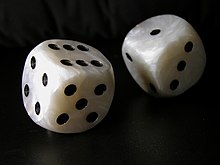Quinquenove
Quinquenove (ital .: five and nine) is a historic dice - gambling with two eyes cubes .
The rules
Any number of punchers can bet against the banker ; the banker throws the two dice
- 5 or 9 points, the punchers win in a ratio of 1: 1,
- 3 or 11 eyes or a doublet , the banker wins,
- 4, 6, 7, 8, or 10 eyes, the sentences stop and the banker rolls again.
(Source: Meyers Konversationslexikon from 1908)
Probability of winning and bank advantage
Of the 36 possible throw combinations, only 18 are decisive for the game, of which
- win eight combinations for the punchers, namely 1–4, 2–3, 3–2, 4–1, 3–6, 4–5, 5–4, 6–3 and
- ten combinations for the banker, namely 1–2, 2–1, 5–6, 6–5, 1–1, 2–2, 3–3, 4–4, 5–5 and 6–6.
The winning probability for the pointer is 8/18 = 44.4%, the bank advantage 2/18 = 11.1%.
An analysis of the game can already be found in the Essai d'analysis sur les jeux de hasard by Pierre de Rémond de Montfort from 1708 and dates from the early days of probability theory .
